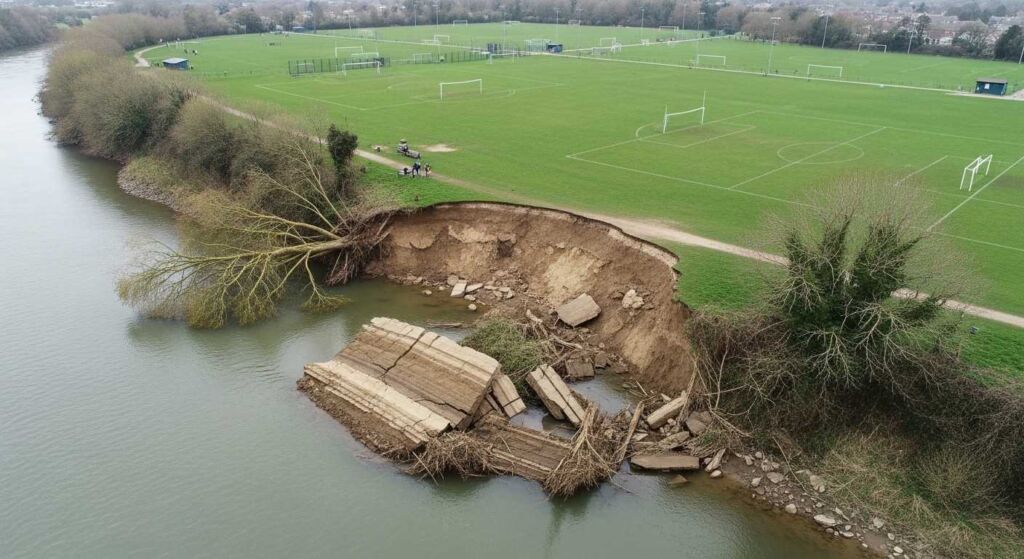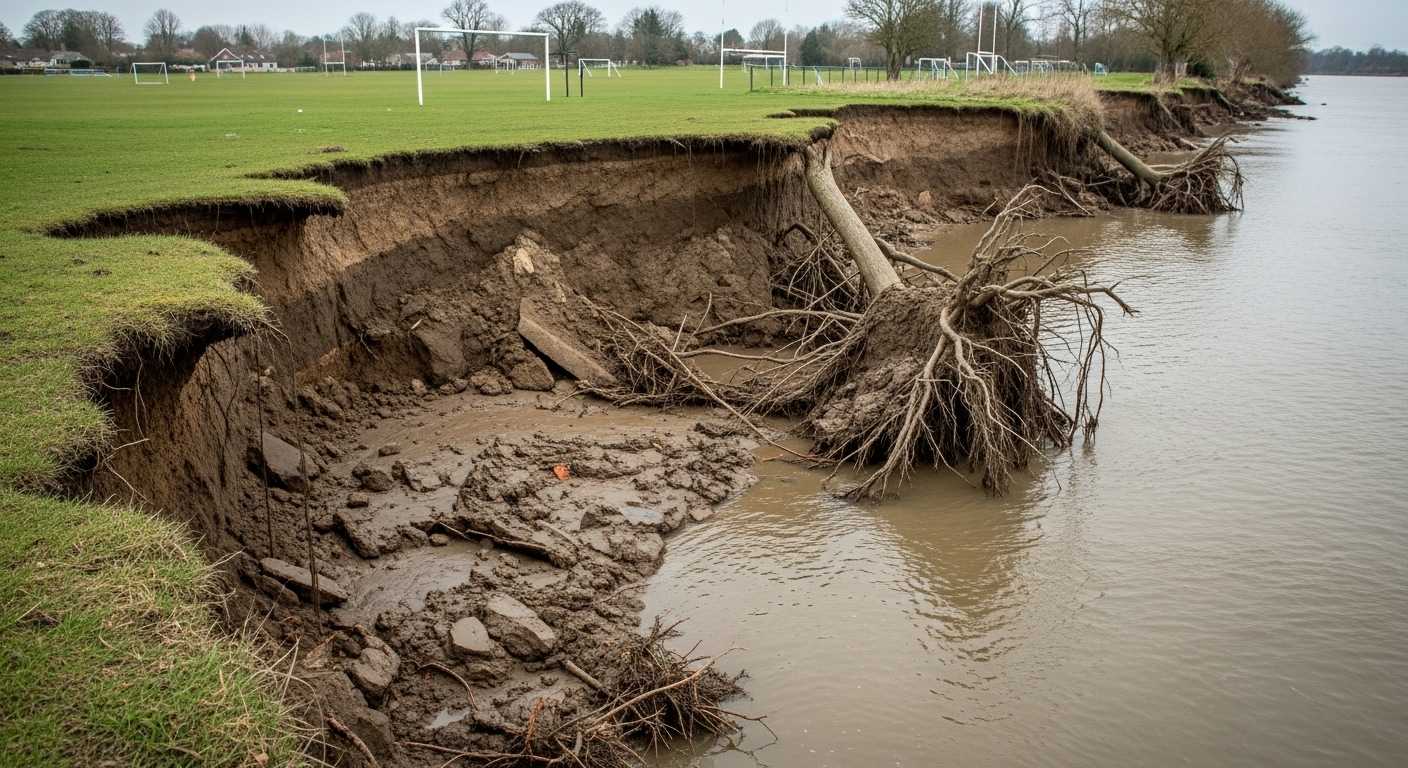Yes, part of the riverbank along the River Stour at Iford Playing Fields (near Christchurch) collapsed in late May 2025. Early on May 28–29, walkers noticed that a section of the river edge had given way – leaving a steep drop and several large trees fallen into the water. In other words, heavy rains and other forces combined to cause a chunk of the bank to slump into the river, leaving the riverside footpath dangerously close to the edge. This collapse was not caused by construction or sudden impact, but by natural forces like erosion and soil saturation (see below).
Where and What: Iford Playing Fields and the River Stour
Iford Playing Fields is a popular riverside park on the western bank of the River Stour, right between Bournemouth and Christchurch. It’s known for open fields, walking paths and river views. The Stour here is quite low-lying and even partly tidal, meaning the river’s flow is sometimes boosted by tides coming in from the sea. Over the years, experts have repeatedly flagged this stretch as flood-prone and erosion-prone. For example, official Environment Agency flood plans note that in November 2002 heavy rains caused the Stour to flood around Iford – even filling homes in an “Iford Bridge” park nearby In short, this riverside setting is beautiful but not immune to flooding or bank erosion.
What Happened in May 2025?
According to local reports, the collapse happened overnight on May 28–29, 2025. Witnesses said they heard a “low rumble” in the early hours, then found that the river bank had abruptly given way. Photos (shared online) show a nearly vertical bank face about 2–3 meters tall where the soil and turf have slid away. A few big trees – probably poplars or sycamores – were uprooted and now lean into or lie in the river. In short, it looks like one big chunk of the bank broke off under its own weight, carrying trees with it. No one was hurt, but the path above the collapse was immediately unsafe.
By mid-June, steps were likely taken to keep people safe (for example, council workers usually rope off or put up warning signs near collapsed banks). In fact, local procedures call for fencing off such a site and surveying the damage before repairs. It is expected that temporary barriers or tape were installed along the slumped edge soon after the fall, and the ground nearby is probably being watched for more cracking.
Why Did the Bank Collapse? (Causes and Factors)
In nature, riverbanks can weaken slowly over time and then fail suddenly. Here are the main factors that likely joined forces at Iford:
-
Heavy rain and saturated soil: In the weeks before the collapse, southern England (including Dorset) saw unusually heavy spring rains. By late May 2025 the ground in the Stour valley was already very wet. Soils can only hold so much water – once saturated, they lose strength. As water fills the tiny gaps in soil (the “pores”), the bank effectively gets heavier and sticks less. In this case, the ground was already close to saturation. When another downpour or high river level came, the soaked soil was prone to slipping.
-
River erosion (“toe erosion”): Flowing water naturally erodes a riverbank’s base (the “toe”). Over months and years, the river undercuts the bank from below. This is especially true on a bend, where the current swings hard against one side. At Iford, the river flows around a curve near Bailey Bridge, so it likely has been gradually scouring out the base there. Imagine carving away the bottom of a sandcastle while the top stays intact – eventually the top loses support and collapses. In other words, even if the collapse seemed sudden, the undercutting had probably been happening quietly until the bank finally gave way.
-
Wind and trees: The night before the collapse, locals also reported strong winds. Trees on the steep bank would have caught those gusts. Large, mature trees have deep roots that normally help hold soil, but they also act like sails in strong wind. If the base of a tree’s roots is already eroded or the soil is soft and heavy with water, a gust can tip the tree over. When a heavy tree comes down, it can pull a mass of earth with it, causing a sudden slump of the bank. This fits with what people saw – multiple big trees leaning or fallen into the river after a loud rumble.
-
Human use: Even everyday park use can add stress. The grassy paths and mowing at Iford mean deep roots are sparse near the edge. People and dogs walking close to the bank can compact the soil (making it firmer but also more brittle). Drainage from the path or fields can flow straight into cracks at the top, adding water. All these small pressures can leave a bank more vulnerable than a wild, heavily-rooted embankment. Over time, such human factors can tip a fragile balance.
In engineering terms, a bank collapse happens when gravity exceeds soil strength. In plain language: the combined weight of wet soil, trees, and anything on the bank becomes too much for the materials holding it together. Once the bottom support is worn away, or the glue between particles is weakened by water, the pile of earth simply falls in. This multi-factor failure is exactly what experts concluded for Iford: heavy rains (high pore pressure), eroding currents at the base, big tree loads, and wind likely combined to trigger the fall.

Effects and Risks of the Collapse
A riverbank failure like this has a few immediate consequences:
-
Safety hazard: The most urgent issue is public safety. The collapse left a nearly vertical drop at the path’s edge. Without a fence, someone could fall in, especially at night or when water levels are high. Cracks in the ground near the slide may widen unexpectedly, too. Even pets or children exploring too close might slip into the water without noticing how unstable the soil is. In similar situations, councils usually cordon off the area for months or longer until experts assess and shore it up.
-
Trail/Access disruption: The park path by the river may be closed or rerouted. Users will see warning signs or barriers while the site is checked. Though this is inconvenient, it’s a standard precaution until engineers confirm the rest of the bank is safe.
-
Environmental impact: When the bank slid, a lot of sediment (soil and debris) dumped into the Stour. This can cause a short-term cloud of mud in the water (higher turbidity), which might affect fish spawning beds, aquatic plants, and small river creatures. However, these effects are usually localized and temporary. In the longer view, the fallen trees can actually benefit the river ecosystem. Submerged logs create habitat: they slow the water, provide hiding places for fish, and form new micro-environments. Of course, if invasive plants or harmful substances had been on the bank, that could be a concern, but there’s no indication of any pollutants in this case.
-
Flood and erosion dynamics: Every time a bank collapses, the shape of the river changes a bit. Losing this section means the river might now flow slightly differently at that spot, which could erode some places faster or slower in future floods. If the bank had held back floodwater like a wall, its loss might also change how floodwaters spread. Local authorities recognize that such collapses reduce flood storage and can shift floodplains, so they typically plan follow-up flood risk management after surveying the site.
Right now (summer 2025), experts would likely be drafting plans to stabilize and restore the bank. Standard practice is to use natural methods first – for example, reshaping the slope to a gentler grade, planting water-loving willows or other shrubs whose roots knit the bank together, and using rock or wooden structures only if needed. These “softer” approaches both secure the soil and support river habitats. But before any work, engineers must survey the collapse. They’ll want to see exactly how deep the scour is, check if any utility lines or paths need rerouting, and decide on permanent fixes.
Learning from the Collapse
Riverbank collapses like the one at Iford Playing Fields are dramatic but not uncommon along natural rivers. In fact, every river bends and shifts over time, and sometimes the banks fail in large pieces. What’s unusual here is that it happened right next to a public park. It’s a reminder that even quiet nature spots are dynamic environments. Scientists and engineers studying Iford’s collapse will take clues (the weather data, soil type, photos of the failure, etc.) to understand exactly what mix of factors was critical. Their findings will help predict future failures and improve maintenance of other at-risk banks along the Stour.
If you’re a visitor to Iford Playing Fields, the main takeaway is to stay on marked paths and respect any warning signs. The riverside can be unpredictable after such an event, especially during heavy rain. Parks staff and local authorities will likely post information so the public knows which areas are closed or dangerous.
In summary, a combination of heavy rains, water erosion and natural wear-and-tear caused a section of the River Stour’s bank at Iford to collapse in May 2025. Experts cite these as the typical reasons riverbanks fail. The result was a sudden landslip: earth and trees fell into the river, leaving a steep drop and raised safety concerns. While it is unsettling, this event illustrates natural processes at work and underscores the importance of monitoring and managing riverside areas.



